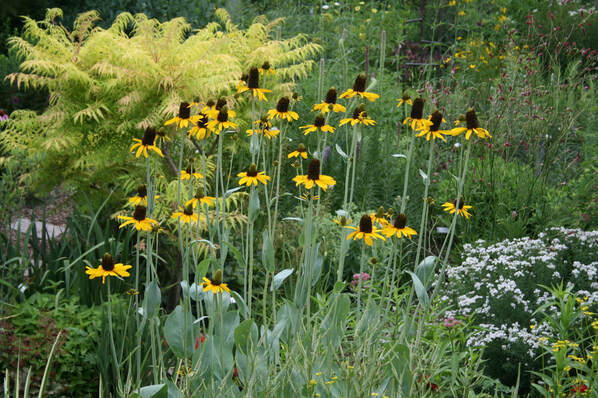I mentioned that in considering lawn removal or bed prep, herbicide may be needed to kill grass or to make repeated controls over extremely weedy areas. For the latter, you want to kill off the current vegetation, allow weed seeds to germinate and reach several inches tall, then kill off again and again; performing this regimen helps exhaust the weed seed bank, a bank that would otherwise ruin the aesthetics of the design, impede establishment for plants you do want (and paid good money for), as well as reducing management time the first year or two when weeding will take up 99% of your garden life. [A note on weeding post planting -- it's best NOT to use chemical control if you can avoid it since you might damage "good" plants or harm wildlife. However, pulling weeds simply brings new weed seeds to the surface. Clipping or mowing weeds before they bloom will reduce weed seed production and may be the best method of weeding as the garden establishes.]
What ensued after the newsletter were many emails, some using swear words, pleading with me to not recommend the use of any herbicides for any reason at all. I can not make that kind of sweeping recommendation at this time. And if you are willing to hear me out, here's why:
- The selective use of some herbicides are essential to controlling invasive weeds. Prairie and woodland conservationists know this, and herbicide used selectively (to target specific species and specific plants or stands of plants) is critical to reviving diverse habitat for wildlife and ecosystem function.
- Herbicide for lawn removal is not only inexpensive, but less polluting (one common chemical may also be less toxic than common organic treatments). To remove lawn effectively one would need a sod cutter, a machine that spews out noxious chemicals. More importantly, sod cutters also increase soil disturbance, which is the very last thing you want in prepping a garden site. That newly-opened soil now has exposed weed seeds ready to take off like gangbusters. When you spray kill a lawn you are leaving the dead lawn in place, which helps control weeds and reduce erosion by acting as a mulch layer. Sure, you could smother the lawn in cardboard and wood mulch, but doing so impedes air and water transfer to / from the soil, reduces soil moisture, increases pests, and makes the planting (and sowing) of a designed meadow garden significantly harder. In other words, don't sheet mulch.
- Using an herbicide one time to prep a landscape for a sustainable, biodiverse, ecologically-thriving landscape is worlds apart from millions of commodity farm fields where a monoculture exists and demands multiple sprays year round for decades. Using an herbicide formulation in the home landscape that targets only foliage -- one that is not a pre-emergent -- reduces the impact of the chemical on wildlife, as does following product directions for factors like temperature, wind speed, and time of day
- If you are an older individual, someone with sudden fatigue syndrome, have a bad back, or are in some other way physically limited by how much you can do, employing an herbicide can be a god send. Same goes if you have limited financial resources that can be better used on procuring plants, because the more plants you have the more sustainable and manageable the space will be -- aka green mulch.
- I'm not an apologist for the wholesale slathering of our nation in pesticides, fungicides, and herbicides, or the large corporations who buy the government to increase profits while our planet's health deteriorates. I know our food and water is poisoned. I am as angry and horrified as the next person. However, the strategic and careful use of herbicides to revive ecological function and biodiversity in the urban environment (and reduce another chemically-dependent monoculture called lawn) is an essential component to sustainable design that actually protects the environment; from invasive weeds getting a foot hold to reducing site erosion, herbicides are an important tool among many. Each site is different, each landowner is different, requiring nuanced approaches tailored to each circumstance. No matter which method you choose to create a native plant garden for wildlife inspired by your local ecoregion, it's important to carefully consider the benefits and drawbacks of each method, including time, cost, labor, pollution, and long-term management goals.
In summary, the benefits of spray killing lawn or weedy beds to prep for a new garden are:
- Less soil disturbance
- Fewer weeds
- Minimizes erosion
- More affordable (and don't solarize -- it kills soil life and produces plastic waste)
- Less physically demanding
- Results come sooner (which means fewer weeds, less erosion / runoff, etc)
- More ecological benefits sooner
In the end we ALL have the same goal -- to revive wildness wherever we can while being wise stewards of nature in the places we live, work, and play. We will get there. We have to .
Second -- and more importantly -- wood mulch inhibits self sowing and plant spread. We want our garden plants to spread ASAP in order to create both an ecological community and to out compete weeds (not to mention slow erosion, sequester carbon, shade / cool our homes, etc). Wood mulch keeps plants in a perpetual state of establishment -- a common refrain espoused by landscape architect Thomas Rainer. In my design practice, we often use a combination of plugs and seeding to create a dense, layered bed quickly, something wood mulch would negate. Working with plants in this way certainly requires greater knowledge about how plants act together in communities, as well as their life cycles above and below the soil line, but learning about them in this way is worthwhile and pays massive dividends. What did nature do before the timber industry invented wood mulch in the 1970s and 80s? Plants. Plants. Plants.



 RSS Feed
RSS Feed

